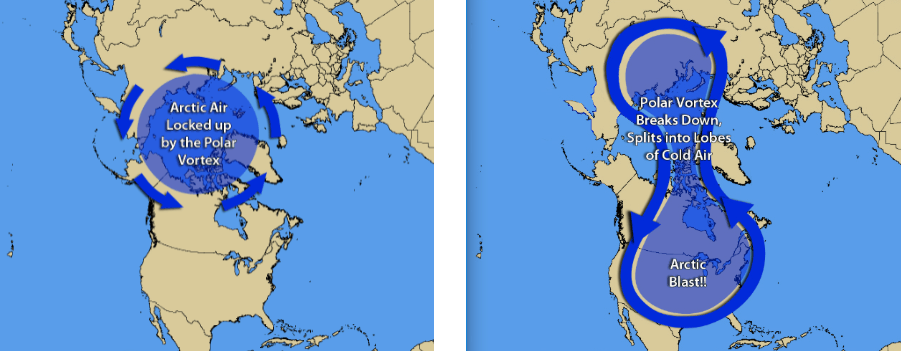People in the central and eastern United States may have to deal with a potentially prolonged period of bitterly cold weather starting later this month. They can blame the polar vortex, which is poised to send plenty of arctic air through the Great White North of Canada right into the Midwest, Northeast, and Southeast regions of our country.
What is the Polar Vortex?
The polar vortex describes a large, counterclockwise-spinning low pressure system above the North Pole. The vortex is in the upper atmosphere, about twice as high as where commercial jets fly. It’s been around for a long time, and it’s within the polar vortex that some of the coldest air lies in the Northern Hemisphere. A strong jet stream, called the polar jet, circulates the high latitudes and usually keeps this arctic air in the Arctic region, kind of like keeping it gated. But sometimes the gate weakens or breaks, allowing the cold air to escape into other regions.
Certain atmospheric events can cause this weakening of the polar jet. A sudden warming of the stratosphere, strong high pressure ridging, or intense Pacific typhoons can all lead to the vortex’s expansion and subsequent squeezing into lobes. These lobes can move southward and cause arctic outbreaks at the surface in Canada, the United States, Europe, and Russia.

Polar Vortex in the Short-Term
The polar vortex can lead to winter temperatures that are well below normal, but you won’t feel the changes instantly. Likely due to stratospheric warming, a lobe of the polar vortex split off around the first of the year. While this was predicted by scientists back in mid-December, it can take a few weeks for the effects to be noticeable at ground level in day-to-day weather.
Our first taste of arctic air from the polar vortex this year will come this weekend, during the time of the season when normal temperatures are at their lowest. Temperatures are expected to be 10 to 25 degrees colder than normal for many areas – from the Dakotas to interior New England to the Gulf Coast. The area impacted includes Kansas City, where the New England Patriots will play the Chiefs in the AFC Championship on Sunday. Temperature at kickoff (5:40 p.m. CSTl) could be in the single digits, with winds chills below zero.
Adding insult to injury, the bitterly cold air this weekend will combine with a storm coming from the Rockies, producing large amounts of snow across the Midwest and Northeast. Icy conditions could develop in some areas, too.
Long-Term Results
This cold snap is just a taste of what’s to come. Computer models suggest the onset of a more persistent and intense arctic outbreak starting between January 25 and 30. In the meantime, temperatures may bounce back and forth as this new, harsh regime becomes established.
“This is more of a transition period,” Michael Ventrice, a meteorological scientist at the Weather Company (owned by IBM), told the Washington Post yesterday. “We’re kicking out the old regime when the Pacific jet was bringing a lot of warmth to the U.S.”
The odds are very good for an extended period of cold and potentially stormy weather going well into February. “I think you can be very confident,” Ventrice added.
Once this pattern becomes entrenched, it typically lingers. After last year’s polar vortex disruption in February, abnormally cold and stormy weather dominated the eastern U.S. in March and part of April. While meteorologists cannot predict exactly how cold it will get this year, where and when all the big storms will form, and who will get the most snow, some of them say we should expect frequent, intense periods of winter weather, including episodes of arctic outbreaks.
Drivers: pour winter additive into your diesel at each fill up in order to avoid gelling. Extended cold snaps will also put stress on batteries with low Cold Cranking Amps (CCA) values and could lead to brake system failures.
Because the developing El Niño could add moisture to storms traveling across the southern U.S., chances for snow and ice could be higher than normal in this region. Ventrice said he expects the cold to penetrate into the Deep South and that, by the end of February, winter will have probably worn out its welcome for many people.











